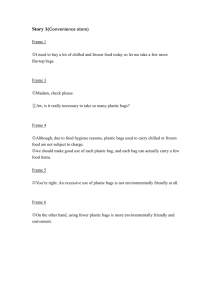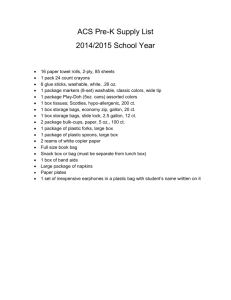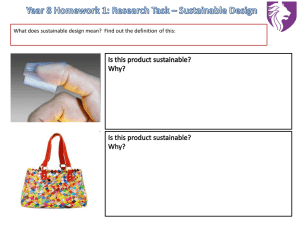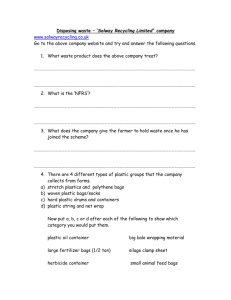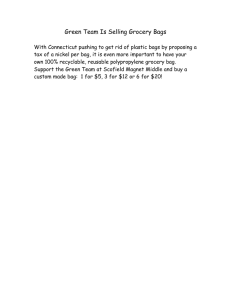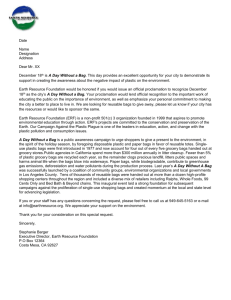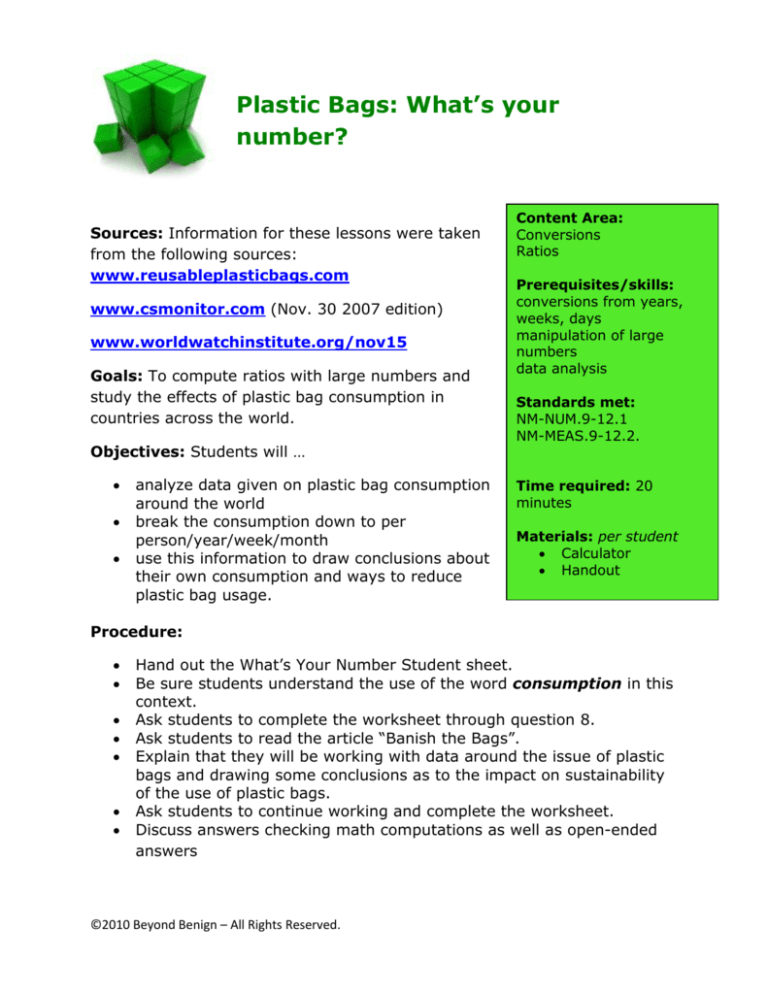
Plastic Bags: What’s your
number?
Sources: Information for these lessons were taken
from the following sources:
www.reusableplasticbags.com
www.csmonitor.com (Nov. 30 2007 edition)
www.worldwatchinstitute.org/nov15
Goals: To compute ratios with large numbers and
study the effects of plastic bag consumption in
countries across the world.
Objectives: Students will …
analyze data given on plastic bag consumption
around the world
break the consumption down to per
person/year/week/month
use this information to draw conclusions about
their own consumption and ways to reduce
plastic bag usage.
Content Area:
Conversions
Ratios
Prerequisites/skills:
conversions from years,
weeks, days
manipulation of large
numbers
data analysis
Standards met:
NM-NUM.9-12.1
NM-MEAS.9-12.2.
Time required: 20
minutes
Materials: per student
Calculator
Handout
Procedure:
Hand out the What’s Your Number Student sheet.
Be sure students understand the use of the word consumption in this
context.
Ask students to complete the worksheet through question 8.
Ask students to read the article “Banish the Bags”.
Explain that they will be working with data around the issue of plastic
bags and drawing some conclusions as to the impact on sustainability
of the use of plastic bags.
Ask students to continue working and complete the worksheet.
Discuss answers checking math computations as well as open-ended
answers
©2010 Beyond Benign – All Rights Reserved.
Plastic Bags: What’s your number?
Student Sheet
Name:______________________________Class period:_________
1. Think about yesterday. Did you buy anything at a grocery store and
receive a plastic bag to hold your purchases? How many bags did you
get? Is this an average number of bags that you as a person use each
day? (Don’t count reusing a bag to carry your lunch, clean up after
your dog, etc.) Come up with a number that you feel reflects an
average of how many new plastic bags you come into contact with
each day:___________
2. Let’s say you are the average American and your plastic bag use
(consumption) is the average use. If there are 272,639,608 people in
the US, how many bags per day would America be using?
_______________
How many per week?__________________
Per year? ________________
3. Below is a chart of actual plastic bag consumption per country per
year. You are going to compute the bags used per person per
year/week/day/minute. But first look closely at the numbers. What
are some of the ways you can deal with numbers that may be too
large to enter in your calculator? Brainstorm some ways you can
make these numbers manageable. Agree as a class what method you
will use.
©2010 Beyond Benign – All Rights Reserved.
Number of plastic bags consumed in 2000
Country Total
bags
/
year
Population
USA
100
billion
272,639,608
Taiwan
20
billion
22,113,250
Ireland
1.2
billion
3,632,944
Kenya
48
28,808,658
million
China
1.1
trillion
#bags/
person/
yr
#
bags/pers
on/wk
#
bags/pers
on/day
1,246,871,951
United
12
Kingdom billion
59,113,439
Australia 6.9
billion
18,783,551
4. Which country uses the most plastic bags per person? _______________
Which country uses the least per person? _________________
6. Did any of these numbers surprise you? Explain.
©2010 Beyond Benign – All Rights Reserved.
7. What reasons can you give for the differences in per person bag usage?
(Remember also the population number includes children.)
8. Compare your calculations from #2 to the chart. Which country fits your
personal bag consumption calculations? _________________________
9. How important do you think it is to reduce our use of plastic bags?
10. In Ireland it now costs $.15 per bag to have your groceries put in plastic
bags. Would you still have your groceries bagged in plastic bags if you had
to pay an extra $.15? If so, what cost would make you not use a bag? How
did you come up with this amount?
11. Ireland uses the money raised by the $.15 tax to fund environmental
programs. In one year it raised $9.7 million. How many bags were
purchased ?
12. If you took the number of plastic bags your family uses in a week, at a
rate of $.15 per bag how much money would your family be spending on
plastic bags in a year?
13. The average re-usable (cloth) grocery bag costs $1.00. How much
money would you save if you used re-usable bags?
©2010 Beyond Benign – All Rights Reserved.
14. What do you think would be an effective way to reduce plastic bag use in
America?
©2010 Beyond Benign – All Rights Reserved.
Plastic Bags: What’s your number?
Teacher Answer KEY
Name:___________________________________ Class period:_________
1. Think about yesterday. Did you buy anything at a grocery store and
receive a plastic bag to hold your purchases? How many bags did you
get? Is this an average number of bags that you as a person use each
day? (Don’t count reusing a bag to carry your lunch, clean up after
your dog, etc.) Come up with a number that you feel reflects an
average of how many new plastic bags you come in contact each day:
_____answers will vary______
2. Let’s say you are the average American and your plastic bag use
(consumption) is the average use. If there are 272,639,608 people in
the US, how many bags per day would America be using? _
answers will vary
How many per week?________________ b. Per year? ________________
3. Below is a chart of actual plastic bag consumption per country per
year. You are going to compute the bags used per person per
year/week/day/minute. But first look closely at the numbers. What
are some of the ways you can deal with numbers that may be too
large to enter in your calculator? Brainstorm on some ways you can
make these numbers manageable. Agree as a class what method you
will use.
©2010 Beyond Benign – All Rights Reserved.
Number of plastic bags consumed in 2000
Country Total
bags
/
year
Population
#bags/
person/
yr
#
bags/pers
on/wk
#
bags/pers
on/day
USA
100
billion
272,639,608
367
7
1
Taiwan
20
billion
22,113,250
904
17
2
Ireland
1.2
billion
3,632,944
330
6
.9
Kenya
48
28,808,658
million
2
.04
.005
China
1.1
trillion
1,246,871,951 882
17
2
United
12
Kingdom billion
59,113,439
202
4
.6
Australia 6.9
billion
18,783,551
367
7
1
4. Which country uses the most plastic bags per person ? Taiwan
Which country uses the least per person? Kenya
6. Did any of these numbers surprise you? Explain. Answers will vary
©2010 Beyond Benign – All Rights Reserved.
7. What reasons can you give for the differences in per person bag usage?
Remember also the population number includes children. If children were
not counted, do you think that the ratio of numbers would have been much
different?
Answers will vary
8. Compare your calculations from #2 to the chart. Which country fits your
personal bag consumption calculations?
Answers will vary
9. How important do you think it is to reduce our use of plastic bags?
10. In Ireland it now costs $.15 per bag to have your groceries put in plastic
bags. Would you still have your groceries bagged in plastic bags if you had
to pay an extra $.15? If so, what cost would make you not use a bag? How
did you come up with this amount?
Answers will vary
11. Ireland uses the money raised by the $.15 tax to fund environmental
programs. In one year it raised $9.7 million . How many bags were
purchased? How does this number compare with the total bags used before
the tax as indicated in the table above?
64,666,667 bags This number is only 5% of the number of bags previously
used. They reduced their bags by 95%.
©2010 Beyond Benign – All Rights Reserved.
12. If you took the number of plastic bags your family uses in a week, at a
rate of $.15 per bag how much money would your family be spending on
plastic bags in a year?
13. The average re-usable (cloth) grocery bag costs $1.00. How much
money would you save if you used re-usable bags?
14. What do you think would be an effective way to reduce plastic bag use in
America?
©2010 Beyond Benign – All Rights Reserved.
World Plastic Bag Consumption: A
Slice of the Pie
Goals:
To use skills for constructing pie charts (circle
graphs) to obtain a better vision of world plastic
bag consumption.
Objectives: Students will…
Analyze plastic bag consumption around
the world
Use knowledge of fractions, decimals and
percents to construct pie charts
Use pie charts to compare world bag usage
Draw conclusions about plastic bad usage
around the world
Explore the effects of reducing plastic bag
consumption by even one small country
on the total world consumption
Content Area:
Statistics/pie charts
Prerequisites:
Fractions, decimals,
percents
Knowledge of protractor
General pie chart (circle
graph construction)
Standards:
NM-NUM.9-12.1
NM- PROB.REP.PK-12.1
Time required:
40 minutes
Materials
Protractor
Straight-edge
Calculator
Student handout
Procedure:
If you have already completed the activity
“What’s your number,” then you can simply
explain that this is a follow-up activity to
further explore world plastic bag consumption.
If not, have students read “Banish the Bag”
handout and have a brief discussion about the role the ordinary plastic
grocery bag has in lives.
Give students handout and allow them to complete the pie charts
(circle graphs)
Check for correct computations and procedures
Discuss open-ended questions
©2010 Beyond Benign – All Rights Reserved.
World Plastic Bag Consumption: A
Slice of the Pie
Student worksheet
Name:____________________________________Class period:_________
The plastic bag. When was the last time you used one? Two? Ten? Can you
imagine leaving the grocery store without one? Did you know that plastic
bags kill wildlife by the hundred thousands and in some countries the litter
caused by plastic bags is so prevalent that the tote has earned the name
white trash. This exercise will give a picture of the general use of plastic
bags around the world.
Read the following table below and answer the questions that follow.
Number of plastic bags consumed in 2000
USA
100 billion
Taiwan
20 billion
Ireland
1.2 billion
Kenya
48 million
China
1.1 trillion
Great Brittan
12 billion
Australia
6.9 billion
1. What is the total number of bags in billions consumed by these
countries. (How will you express China’s and Kenya’s amounts in
billions?) Billion____________.
©2010 Beyond Benign – All Rights Reserved.
2. Complete the following chart:
Country
Degrees
Fraction of Total
Decimal
Percent
Totals
3. Now construct a circle graph. Be sure to include all appropriate labels!
(Note, some slices of the pie will be very small. Round when necessary but
be sure that percents and degrees add up appropriately.)
©2010 Beyond Benign – All Rights Reserved.
4. Now let’s look at this data from a little different perspective. Below is a
table that highlights the bags per person per year usage of each country.
Make a circle graph of the following data.
Country
Bags/per/yr
USA
367
Taiwan
904
Ireland
330
Kenya
2
China
882
United
Kingdom
202
Australia
367
Fraction
Totals
©2010 Beyond Benign – All Rights Reserved.
Decimal
Percent
Degrees
5. How does the circle graph in #4 compare with the one you made in #4 ?
What conclusions can you draw about bag usage from this graph that you
did not see in the first one?
6. After 2000, Ireland passed a law that required a $.15 tax on each plastic
bag sold. By 2002, this one act reduced Ireland’s plastic bag consumption
by 90%. What was Ireland’s total plastic bag consumption 2002?
7. How much will the change in Ireland’s plastic bag consumption change the
make-up of the first circle chart? The second circle chart? Explain your
reasoning.
8. In June 2008, right before the Beijing Olympics, China also instigated a
restriction on the use of plastic bags, limiting use to only those bags of a
certain thickness. If China has the same results as Ireland, how would this
outcome change the first circle graph? The second? Explain.
©2010 Beyond Benign – All Rights Reserved.
9. Many other countries have already banned or made strict regulations
concerning the use of plastic bags. Even Kenya, with the lowest of all the
numbers has instituted a ban. While a few individual states have begun to
take action, the United States is still one of the few major countries which
has not attacked this problem head-on. What are some reasons that you
can think of that has caused the US to fall behind in recognizing this
problem? What would take to make you personally decrease your plastic
bag usage? Would you do it voluntarily for the sake of the environment?
What if there was a tax? Or would it take a ban? Explain.
©2010 Beyond Benign – All Rights Reserved.
World Plastic Bag Consumption: A
Slice of the Pie
Teacher Answer KEY
Name: ____________________________________Class period:_________
The plastic bag. When was the last time you used one? Two? Ten? Can you
imagine leaving the grocery store without one? Did you know that plastic
bags kill wildlife by the hundred thousands and in some countries the litter
caused by plastic bags is so prevalent that the tote has earned the name
white trash. This exercise will give a picture of the general use of plastic
bags around the world.
Read the following table below and answer the questions that follow.
Number of plastic bags consumed in 2000
USA
100 billion
Taiwan
20 billion
Ireland
1.2 billion
Kenya
48 million
China
1.1 trillion
Great Britain
12 billion
Australia
6.9 billion
1. What is the total number of bags in billions consumed by these countries.
(How will you express China and Kenya’s amounts in billions?)
1240.148 billion
©2010 Beyond Benign – All Rights Reserved.
2. Complete the following chart: (Note, some slices of the pie will be very small. Round when necessary
but be sure that percents and degrees add up appropriately. Note these numbers are in billions
Country
Fraction of Total
Decimal
Percent
Degrees
USA
100/1240
.08
8
29
Taiwan
20/1240
.016
1.6
5.8
Ireland
1.2/1240
.0009
.09
.324
Kenya
.048/1240
.000038
.0038
.014
China
1100/1240
.88
88
319
United
Kingdom
12/1240
.0096
.96
3.4
Australia
6.9/1240
.0056
.56
2.46
3. Construct a circle graph. Be sure to include all appropriate labels!
USA
Taiwan
Ireland
IG
F
Kenya
D
China
United Kingdom
Australia
B
E
H
©2010 Beyond Benign – All Rights Reserved.
4. Now let’s look at this data from a little different perspective. Below is a
table that highlights the bags per person per year usage of each
country. Make a circle graph of the following data.
Country
Bags/per/yr
Fraction
Decimal
Percent
Degrees
USA
367
367/3054
.12
12
43
Taiwan
904
904/3054
.29
30
107
Ireland
330
330/3054
.11
11
39
Kenya
2
2/3054
.0007
.07
.24
China
882
882/3054
.29
29
104
United
Kingdom
202
202/
.06
6
23
Australia
367
367/3054
.12
12
43
Totals
3054
©2010 Beyond Benign – All Rights Reserved.
World Plastic Bag Usage Per Person Per Year 2000
D
Australia
China
J
Kenya
Ireland
K
Taiwan
USA
United Kingdom
B
L
F
GI
5. How does this circle graph compare with the one above? What
conclusions can you draw about bag usage from this graph that you did not
see in the first one?
Answer will vary
6. After 2000, Ireland passed a law that required a $.15 tax on each plastic
bag sold. By 2002, this one act reduced Ireland’s plastic bag consumption
by 90%. What was Ireland’s total plastic bag consumption 2002?
10% = 120,000,000
©2010 Beyond Benign – All Rights Reserved.
7. How much will the change in Ireland’s plastic bag consumption change the
make-up of the first circle chart? The second circle chart? Explain your
reasoning.
It will hardly change the first chart because Ireland is already such a small
piece of the pie. Meanwhile, it will change the overall total to a smaller
number, 2754, and its own percent 1.2 and degree will only be 4
8. In June 2008, right before the Beijing Olympics, China also instigated a
restriction on the use of plastic bags, limiting use to only those bags of a
certain thickness. If China has the same results as Ireland, how would this
outcome change the first circle graph? The second? Explain.
The first graph will change significantly as China uses 88% of the bags when
compared to these countries. After its reduction, China will only use about
44% of the bags when compared with these other countries.
9. Many other countries have already banned or made strict regulations
concerning the use of plastic bags. Even Kenya, with the lowest of all the
numbers has instituted a ban. While a few individual states have begun to
take action, the United States is still one of the few major countries which
has not attacked this problem head-on. What are some reasons that you
can think of that has caused the US to fall behind in recognizing this
problem? What would take to make you personally decrease your plastic
bag usage? Would you do it voluntarily for the sake of the environment?
What if there was a tax? Or would it take a ban? Explain.
Answers will vary.
©2010 Beyond Benign – All Rights Reserved.
Too Many Bags! (A Voluminous
Amount!)
Teacher Background Information:
This could be either an introduction to volume or a
follow-up activity. It could also be a way to
incorporate volume into an algebra curriculum.
Information for this lesson was taken from the
following sources: www.reusableplasticbags.com
Goals: Students use place value, scientific notation,
general number sense, spatial awareness and volume
to allow students to conceptualize the enormity of the
number of plastic bags used in the US each year.
Objectives: Students will…
use plastic bags to model the concept of
volume
correctly compute the volume of their
classroom
show knowledge of place value, scientific
notation, estimation, and the ability to
communicate their thinking.
Content Area:
Volume
Number sense
Estimation
problem solving
Prerequisites:
measuring skills
estimation skills
scientific notation
Standards met:
NM-NUM.9-12.1
NM-MEA.9-12.2
NM-PROB.COMM.PK 12.2
Time required:
1 hour
Materials:
Box
Plastic grocery bags
(enough to fill the box)
Calculators
measuring tape You can
de:
Procedure:
Tell students that the world uses about 2 trillion
plastic bags per year.
Ask the students to tell you what they think 2 trillion plastic bags looks
like? Would it fit in a small car, a small house?
Explain that today you are going to help them get their head around
the concept of how many plastic bags we use and how much waste it
creates.
Have students complete questions 1 – 3 on the handout.
* Note that at this point you can decide on how you would like to fill the box
with the bags. One method entails making the bags into “cubic” bags to get
an idea of the cubic units entailed in volume. This method also helps derive
the formula as you can layer the “cubic” bags to get the idea of area of the
©2010 Beyond Benign – All Rights Reserved.
base x height. Most of the following directions includes using “cubic bags.”
However, you can also simply stuff as many bags as possible into the box.
This method circumvents the possible confusion between the arbitrary size
of each bag and the actual measurements of the box that need to be used to
compare the box size with the room size in a subsequent step. You will need
to adjust the directions below according to what methods you use to fill the
box.
Explain that you are going to use the idea of volume to get an idea of
the amount of plastic bags that we use. Show the students the box
and the bags. Explain that you are going to fill the box with as many
bags as will fit.
Have students complete questions 4 and 5.
Write their estimations on the board and discuss how they came up
with their answers.
Explain that each student will be responsible for rolling the bag into a
ball. Each “cubic ball” will ultimately represent one “cubic bag” of
volume. You might here have students review why volume is cubic
and how it is different from surface area (the outside of the box) and
perimeter( the edges of the box) NOTE: You can also simply have the
students stuff as many bags as possible in the box and not worry
about making the bags into “cubes.”
Hand out bags and have students fold /roll them into shapes that are
approximately cubes. (You could use rubber bands to keep the bags in
their shapes)
Now have the students actually come up and put their bags into the
box, keeping track of how many are going in and starting with a layer
of bags on the bottom.
Figure out whose estimation was the closest.
Now have students complete the worksheet.
* NOTE THAT YOU NEED TO BE SURE THAT THE STUDENTS MAKE THE
CONNECTION THAT THE VOLUME OF THE BOX WHEN COMPARED TO THE
VOLUME OF THE ROOM CANNOT BE DONE IN TERMS OF “CUBIC BAGS.”
THIS PART OF THE ASSIGNMENT WILL DEPEND ON THE SIZE BOX YOU
USED ( IS IT BEST MEASURED INITIALLY IN CENTIMETERS or INCHES?)
AND HOW IT COMPARES WITH THE SIZE ROOM YOU HAVE ( IS IT BEST
MEASURED IN METRES or FEET?) AND MAKE THE NECESSARY
ADJUSTMENTS.
©2010 Beyond Benign – All Rights Reserved.
Too Many Bags
Student Worksheet
Name:____________________________________Class period:_________
Plastic bags permeate our everyday lives. We get them by the dozens each
week through our grocery stores as well as other sources.. In 2005, the US
alone consumed 100 billion plastic bags. While some of these bags were
recycled ( a costly process) and others reused, most ended up in landfills,
oceans, caught in trees or even eaten by animals in the wild. The disposal of
plastic bags creates a huge impact on our landfills and overall environment.
1. Write out the number 2 trillion. ______________________ Can you
name each place value?
2. When you think of this number, what items in our world come to mind?
(i.e., what kinds of things on earth would come in trillions?)
3. Write 2 trillion in scientific notation _________________ (you might
choose to use this form later for a calculation)
4. Estimate the number of “cubic bags” (or just bags) that you think will fit
in the box:_________. Explain below how you derived at this number:
©2010 Beyond Benign – All Rights Reserved.
5. Compare your number with your neighbor’s. Are your answers similar?
Were your methods similar? Summarize below (don’t just say “yes” or
“no”):
Answer #6 after you have filled the box with bags.
6. How close was your estimation? What can you say accounted for the
closeness?
7. How can you use what you know about volume to predict how many bags
would fill this room? Write your prediction here___________.
8. Now compute the real volume of the box.
Dimension of box: Length ________ Width ________ Height _______
Compute the volume. Show your equation and all of your work.
©2010 Beyond Benign – All Rights Reserved.
9. Compute the volume of your classroom:
Dimensions of classroom: Length ______ Width____ Height ______
(Note: Are your box dimensions and your classroom dimensions in the
same units? How do you need to adjust them if they are different?)
Compute the volume. Show your equation and all of your work.
10. Now explain how you will use the numbers you have, including the
number of bags that fit in the box, to determine how many bags would
fit in the room. Then show the computations.
11. Does your room hold all 2 trillion bags? If not, how many rooms would
it take? Does your school have that many rooms?
12. How surprised were you with your findings?
13. List ways that you and your classmates could cut down on the
number of plastic bags you consume, daily, weekly monthly. (note that
paper bags have their own detrimental side effects to the
environment.) What are some things that stores could do? That your
community could do?
©2010 Beyond Benign – All Rights Reserved.
Too Many Bags Student
Worksheet:
Teacher Answer Key
Name:____________________________________Class period:_________
Plastic bags permeate our everyday lives. We get them by the dozens each
week through our grocery stores as well as other sources.. In 2005, the US
alone consumed 100 billion plastic bags. While some of these bags were
recycled ( a costly process) and others reused, most ended up in landfills,
oceans, caught in trees or even eaten by animals in the wild. The disposal of
plastic bags creates a huge impact on our landfills and overall environment.
ANSWERS WILL VARY FOR MOST OF THE WORKSHEET
1. Write out the number 2 trillion. _2,000,000,000,000_
Can you name each place value?
trillions, hundred-billions, ten-billions, billions, hundred-millions, tenmillions, millions, hundred-thousands, ten-thousands, thousands,
hundreds, tens, ones
2. When you think of this number, what items in our world come to
mind? (i.e., what kinds of things on earth would come in trillions?)
Answers will vary
3. Write 2 trillion in scientific notation __2 x 1012__ (you might choose to
use this form later for a calculation)
All other answers will vary
©2010 Beyond Benign – All Rights Reserved.
Banish the Bags: Used for minutes but last
1,000 years... The life cycle of plastic bags
They are handed out in their billions, used for a few minutes then discarded to pollute the earth for
hundreds of years. Here we trace the life cycle of a plastic bag.
- RAW INGREDIENTS
The five trillion carrier bags produced each year start life as crude oil. Demand is so high that 0.2
per cent of the world's oil is used to make them - about 60million barrels, worth about £3billion.
- OIL TO PLASTIC
Most plastic bags are made from HDPE, or high density
polyethylene, a strong, light, rigid plastic also used in food
containers, milk bottles and pipes.
Petroleum is heated to produce ethylene gas. This is
converted to polyethylene, which looks like porridge, then
forced through holes into strings, which are cut into
granules.
These are heated, stretched and cooled to make bags.
- BAGS
The majority of our bags come from China, India, Thailand
and Malaysia. Because HDPE is naturally transparent, dyes
are used to give color.
They are printed with supermarket logos in the Asian factories, then shipped out. Each one costs
about 0.02 cents.
- DISTRIBUTION
By the time they arrive in stores the bags will have travelled between 4,000 and 8,000 miles.
Then they are driven to distribution centers and on to stores.
Unlike paper bags, they are compact and lightweight. According to the plastics industry, 150,000
plastic bags fit on two pallets.
©2010 Beyond Benign – All Rights Reserved.
The same number of paper bags would fill a 40ft truck. Plastic is also very strong. Supermarket
bags can hold at least 22lb of shopping. Some hold twice that.
Many dead marine mammals have been found with bags in their stomachs and the seas around
the world are very plastic-polluted.
- USE
For every one of us, 216 plastic bags a year are handed out. A typical free supermarket bag is
used for an average of 20 minutes before it is thrown away.
- LANDFILL
A third of us use plastic bags as bin liners. Another third re-use them for shopping.
But eventually, more than 98 per cent end up in a landfill. About 200 million litter the
countryside.
- DECAY
Plastic bags have only been around since the Thirties, so no one knows how long they last. But
scientists estimate they take 400 to 1,000 years to vanish.
Some are designed to turn into carbon dioxide, water and compost within a month or two - but
only in a composter.
Chemicals in some bags, particularly the inks used in printing, can leak and cause poisoning or
turn into noxious compounds if burned.
In the oceans, they can survive intact for years. A recent Greenpeace report found that one
remote area, called the Pacific Gyre, a whirling current, contained more than a million items of
plastic microdebris in every square kilometer of ocean surface.
©2010 Beyond Benign – All Rights Reserved.
Plastic can even be useful to some creatures, but they don't realize the dangers. Here, a pair of
ospreys have used discarded plastic sheeting to make their nest
- RECYCLING
Only 5 per cent of us recycle bags. Facilities are so limited that about 100 million a year are
shipped back to China. There, they are shredded, melted and turned into plastic beads.
The dyes and inks in bags do not make them harder to recycle - but they turn the plastic grey or
black. The beads can be used to make new bags.
Plastic bags are cheaper than paper bags, but may be worse for the environment.
Four times as much energy is used to produce them and 85 times as much to recycle them, the
U.S. Environmental Protection Agency says.
But paper takes up nine times the space of a plastic bag at landfill. And paper bags are four times
more expensive.
- END OF LIFE
In the oceans, plastic bags and other waste kill a million sea birds and 100,000 animals such as
whales, dolphins, turtles and seals, each year.
Once the animal's body has rotted, the bag is released back into the sea, to kill again and again.
©2010 Beyond Benign – All Rights Reserved.
Things to think about:
100 million bags per week go to a landfill
It takes between 15 and 1000 years for a plastic bag to break
down only to contaminate soil and water sources
Production of plastic bags requires vast amounts of oil
Hundreds of thousands of sea ocean mammals die each year from
eating discarded plastic
(From www.bringyourownbag.com)
©2010 Beyond Benign – All Rights Reserved.

